Lanarkshire Tramways Company
History
Following several abortive tramway schemes, Lanark County Council and the town councils of Hamilton and Wishaw, formed a committee to look into what kind of tramway they desired, and which routes would best benefit the area. Agreement was reached on the 10th November 1899, the plans being taken forward by a group of promoters that had the backing of the British Thomson-Houston Company, which had recently opened Cork Electric Tramways, and would go on to either own or control the Chatham and District Light Railway, Isle of Thanet Electric Tramways, and Paisley District Tramways.
On the 30th July 1900, the promoters obtained powers — under the Hamilton, Motherwell and Wishaw Tramways Act, 1900 — to build circa 8.5 miles of electric tramway. The same act also authorised the incorporation of a company to build and operate the tramway, the Hamilton, Motherwell and Wishaw Tramways Company.
Construction started in June 1902, the line — between Blantyre, Hamilton, Motherwell and Wishaw — finally opening on the 22nd July 1903, having been delayed by mining subsidence.
Powers for a significant expansion of the system (a further 20 miles) were obtained on the 11th August 1903, under the Lanarkshire Tramways Order Confirmation Act, 1903. This act also authorised a change of name, to the much more succinct Lanarkshire Tramways Company.
The first of the new lines, from Hamilton to Larkhall opened partially on the 15th July 1905 and fully, on the 23rd July 1905. Progress with building the other lines was slow, the company only having time to open the extension from Blantyre to Cambuslang (on the 20th June 1907), before having to seek an extension to the time allowed for construction. This was duly granted on the 1st August 1908 under the Lanarkshire Tramways Order Confirmation Act, 1908; importantly, the act also included powers to run omnibuses in connection with the tramway, and within 5 miles of it.
The next extension to open was from the Hamilton boundary to Uddingston (in February 1909), and Wishaw to Newmains (in June 1909), but this was followed by yet another hiatus, purportedly due to a combination of financial constraints and mining subsidence, the line to New Stevenson not opening until August 1911. Meanwhile, the company's powers for further lines had expired, much to the exasperation of Lanark County Council, which now pressed ahead on its own, obtaining powers for an additional 9 miles of tramway on the 7th August 1912, under the Lanark County Tramways Act, 1912. The act also included powers to buy the company, and conversely, should the council subsequently choose not to do so, then the company could buy the council-owned tramway lines.
The new lines opened between September 1913 and February 1914, taking the system to its final size of 28.43 miles, the largest company-operated tramway system in Scotland. The 4ft 7¾ins-gauge overhead electric tramway comprised a large circular route (between Hamilton, Motherwell, New Stevenson, Mossend, Bellshill, Tannochside, Uddingston and Bothwell) with branch lines radiating to Newmains in the east (via Wishaw), Larkhall in the southeast, Cambuslang in the northwest, and Holytown in the northeast. Although the tracks of the LTCo were connected to those of Glasgow Corporation Tramways at Cambuslang, no through running ever took place.
Meanwhile, the LTCo had branched out into omnibus operation, introducing its first services in April 1913, and though it had plans for a significant expansion, these were placed in abeyance at the outbreak of the Great War. The system was heavily used during the conflict, and was particularly badly impacted by men volunteering for the armed services, having to resort to putting all its conductors (male) on driving, and the inspectors too, all being replaced by women. As with many systems, that of the LTCo emerged from the Great War in badly run-down condition; however, and despite post-war inflation, the company set about putting the tramway in order. It also revived its omnibus expansion plans, obtaining powers on the 23rd December 1920 — under the Lanarkshire Tramways Order Confirmation Act, 1920 — to run anywhere within Lanarkshire, including Glasgow.
In May 1921, the company completed the purchase of the Lanark County Council lines, which it was entitled to do under the enacting legislation.
Dark clouds were, however, on the horizon, in the form of intense motorbus competition, which either operated illegally (i.e., without licences) or with the blessing of the various councils, which granted them licences with no thought for their impact on the tramway. The company responded by expanding its own motorbus services, such that it owned circa 35 vehicles by 1924, more following at the end of that year with the purchase of the Scottish General Transport Company's Airdrie and Coatbridge operations. These were, however, a drop in the ocean compared to the competition, a census taken in the area in 1925 registering 230 vehicles, 200 of which competed directly with the tram services.
1925 was in fact destined to be the watershed for the tramway, which went from a very profitable enterprise, having paid and an average dividend of just over 6% annually to its shareholders (between 1903 and 1918), to one incurring heavy losses. The situation was such that the company even had to withdraw tram services between Hamilton and Uddingston due to the congestion caused by the plethora of competing buses.
The tramway company was of course at a great financial disadvantage compared with its competitors, having paid significant sums for road and bridge widenings, and continuing to pay for the upkeep of the roads along which it and the motorbuses operated. On top of this came significant annual payments to the respective councils in the form of rates and wayleave, which in 1926, the company found itself struggling to pay. Despite pleading with the councils for something to be done about the unfair financial burden, and the unfettered competition, the councils responded by threatening the company with liquidation, this only being fended off by a deal to spread the payments over a longer timeframe.
With the motorbus competition paying about a seventh of the cost of running a tram, and the councils being unwilling to help, the writing was clearly on the wall for the tramway. One wonders what went through the minds of the councillors at the time, given that they were set to lose a significant proportion of their income should the tramway be closed.
Despite a small profit in 1927, the stark situation facing the company is best illustrated by its share price, which plummeted from 24 shillings in 1924 to 1 shilling in 1927. For its part, the company could only follow the prevailing wind, expanding its bus services and gradually withdrawing the tram services. In 1929, it applied for a provisional order to abandon the tramway and replace the services with motorbuses, as well as to change the name of the company to the Lanarkshire Traction Company; these powers were granted on the 20th December 1929 under the Lanarkshire Traction Order Confirmation Act, 1929.
Having already withdrawn many services, Larkhall to Uddingston, and Newmains to Cambuslang followed on the 6th October 1930, the last tram of all — from Bellshill to Motherwell —running on the 14th February 1931.
Uniforms
Several photographs have survived from the first year or so of the tramway's life (i.e., 1903), which show staff wearing informal attire, along with a variety of caps, including plain kepis. This situation arose on many tramways, and was usually the result of uniforms not being delivered in time for service inauguration, though this does not appear to be the case with the LTCo, as uniforms seem not to have made an appearance until around 1905, so it was probably a deliberate policy on the part of the company. When uniforms were finally issued, they took the form of single-breasted jackets with five buttons (bearing the company title around a monogram of LTC initials — see link), two breast pockets (with button closures), stand-up collars and epaulettes (with button fastenings); the collars bore an employee number on both sides, whilst the epaulettes appear to have carried a badge of intertwined company initials — 'LTC' — probably identical to those worn on the caps. The tensioned-crown, peaked caps bore standard, off-the-shelf, script-lettering grade badges — 'Motorman' or 'Conductor' — above which, the intertwined company initials badge was worn. All the badges were probably brass to match the buttons. The basic style of the uniform does not appear to have been altered during the entire history of the company's tramway endeavours, right up until closure in 1931.
By 1909, a service stripe had been added to the jacket sleeve, apparently one for each year's service, five being denoted by a star. Tramcar crews were also provided with double-breasted greatcoats with five pairs of buttons, high fold-over collars (devoid of badges), and possibly epaulettes.
Inspectors initially wore typical tramway inspector garb, i.e., single-breasted jackets with hidden buttons (or more likely a hook and eye affair), two slit breast pockets, and stand-up collars; the latter bore 'Inspector' in embroidered script lettering on both sides. The jackets (including the slit breast pockets) were edged in a finer material than the main jacket, the sleeves also being embellished with a chevron of the same material. Headgear initially took the form of a kepi-style cap, which probably bore the grade — 'Inspector' — in embroidered script lettering on a hat band, above which was worn the standard 'LTC' intertwined initials badge; at some point these caps were superseded by a tensioned crown, peaked type.
The LTCo also employed the services of a chief inspector; the uniform was identical to that worn by inspectors, save for the cap, which appears to have carried the full grade — 'Chief Inspector' — on a hat band that was possibly of a different colour than the main uniform.
In common with the vast majority of UK tramway operators, the LTCo employed women during the Great War, to replace male staff lost to the armed services. These ladies were initially employed as conductresses (from early 1915), but later on also as motorwomen (apparently not with the greatest of success) and inspectresses. After the war, the inspectresses were switched to driving duties, and as far as is known, women continued to be employed right through to the end of tramway operation in 1931. Photographs of these ladies are scarce, and those that have survived suggest that single-breasted jackets and long, matching skirts were worn, along with a shirt and tie, though what insignia was carried is currently unclear. Headgear took the form of a baggy cap with a glossy peak (a so-called motor cap), which bore the standard 'LTC' intertwined company-initials badge. For colder weather, the ladies were issued with heavy, double-breasted greatcoats similar to those worn by their male colleagues. Motorwomen were also issued with long, double-breasted, waterproof coats (with unmarked buttons, along with rain covers for their caps, made from the same material as the coats (see below).
Further reading
For a history of the system, see: 'Lanarkshire's Trams' by A W Brotchie (Ed); N B Traction (1993).
Images
Motormen and conductors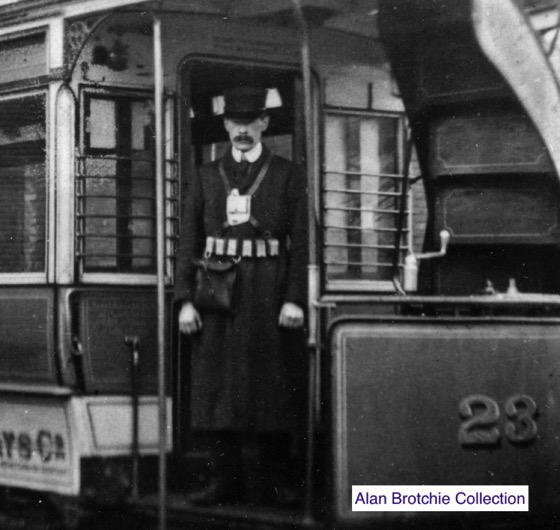
A rather stern-looking conductor festooned with tickets and other accoutrements, aboard the platform of Tramcar No 23 — photo undated, but probably taken in late 1903 or early 1904 given that the rocker panel bears the original name of the company, but crossed out: 'The Hamilton, Motherwell & Wishaw Tramways Co'. He appears to be wearing informal attire, along with a plain kepi-style cap.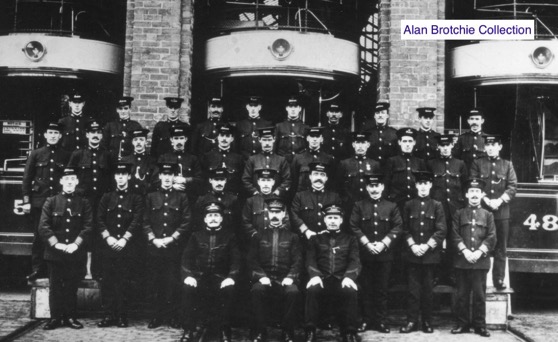
A small group of motormen, conductors and inspectors, along with the chief inspector, assembled for the camera at the Power House in 1908.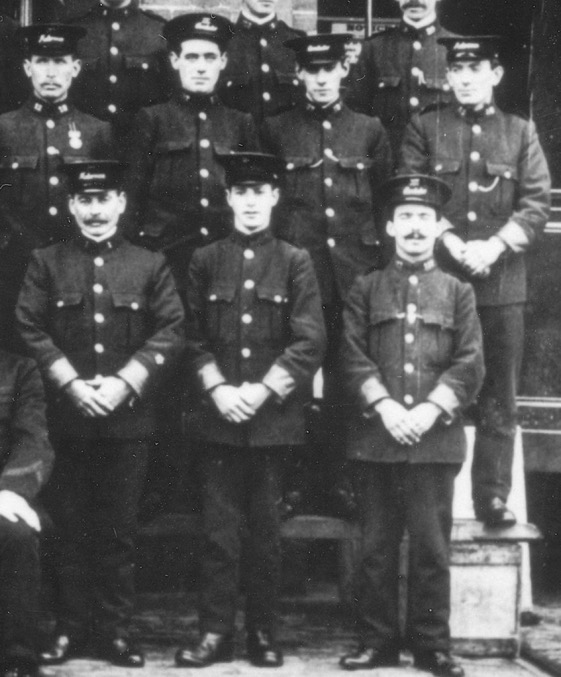
An enlargement of the above photograph showing some of the motormen and conductors. Employee No 1 on the left, who bears a passing resemblance to a certain Georgian dictator, has a star-shaped badge on his left sleeve, which denoted 5-years' service.
General pattern script-lettering cap badges ('Motorman' and 'Conductor') of the type used by the Lanarkshire Tramways Company — brass.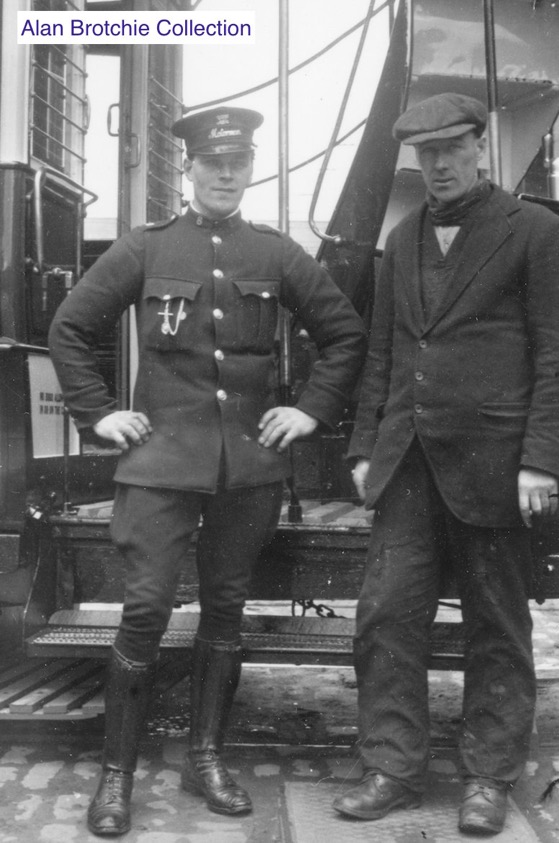
A nice study of a swanky-looking motorman (Employee No 8) and a rather less sartorially conscious fitter, taken at the Power House — photo undated.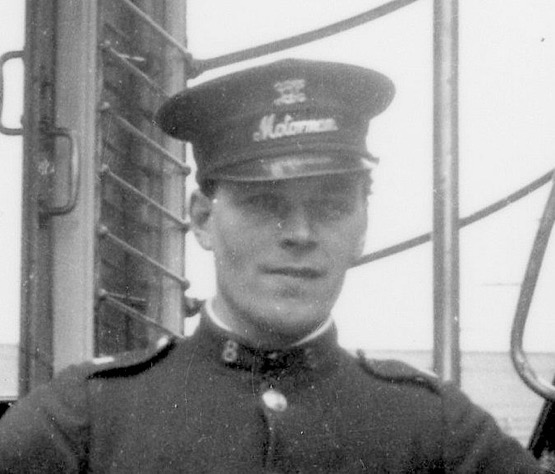
An enlargement of the above photograph showing details of the motorman's uniform insignia and cap, which shows that the badge worn above the grade badge consisted of intertwined 'LTC' initials. The epaulette badges do not appear to be an '8' (his employee number, which is seen clearly on his collar), so were more than likely the same 'LTC' badge that was worn on the cap.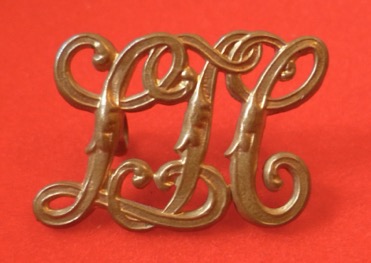
Lanarkshire Tramways Company cap badge — brass. Author's Collection.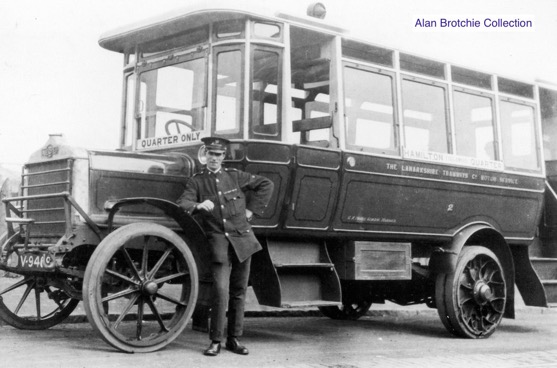
An LTCo driver-cum-motorman leans against one of the company's new AEC buses (No 2) — photo undated, but probably taken in 1919 judging by the pristine condition.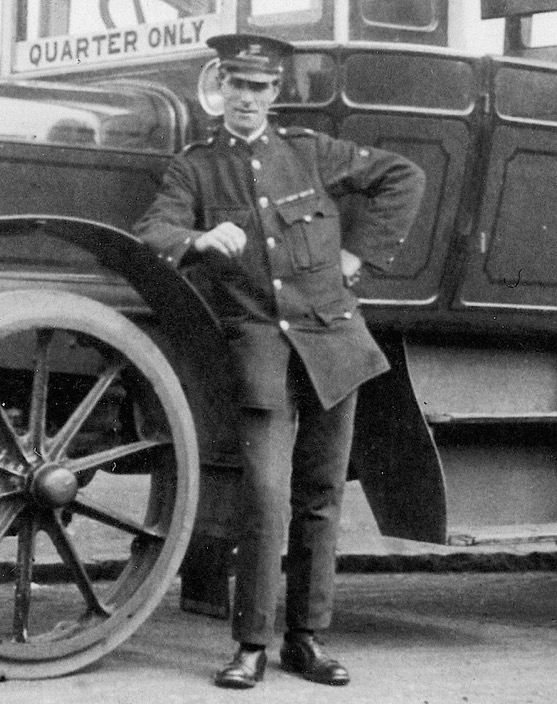
An enlargement of the above photograph revealing the subject to be a motorman, or at least that is what his cap says. He also has a fine medal ribbon, almost certainly from his Great War service.
Senior staff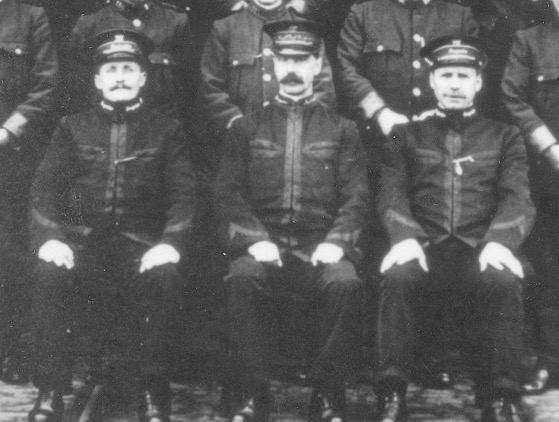
An enlargement of the 1908 staff photograph above showing Inspector Brookes (left), Chief Inspector Haggerty (middle) and Inspector Williamson (right). The jacket edges, pockets and sleeves are all embellished with material of a finer quality than the main body of the jacket.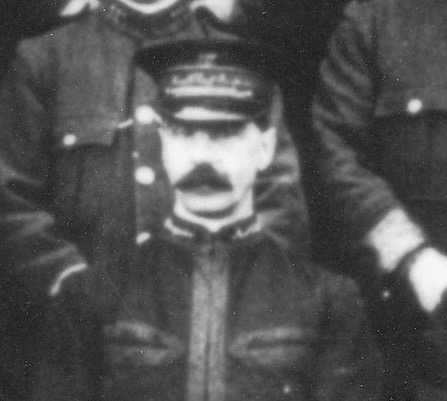
A close-up of Chief Inspector Haggerty, which shows that his cap bore his grade in full — 'Chief Inspector' — in embroidered script lettering, with the standard 'LTC' intertwined initials badge above.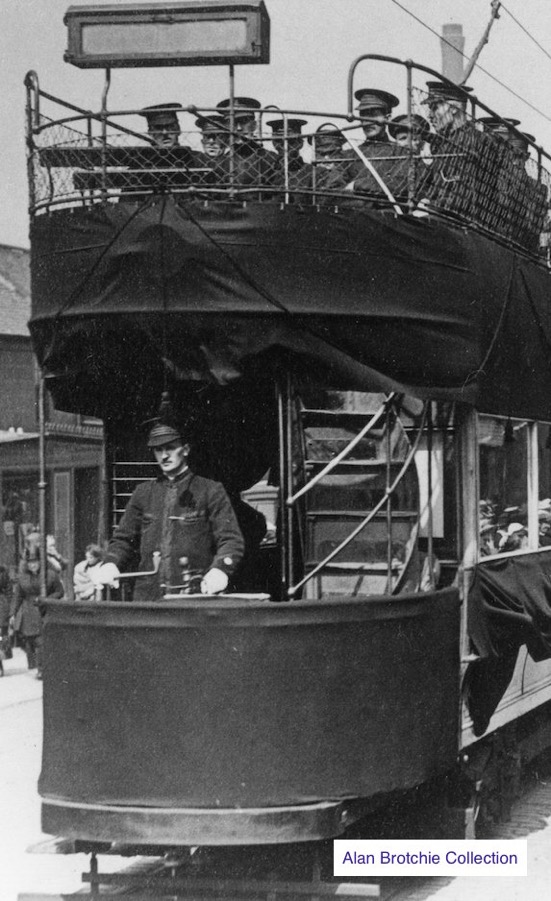
An inspector at the controls of Tram No 72 in Merry Street, Motherwell around 1914. The tram is decked out in black and is carrying the remains of the first company inspector to die in service; more inspectors are to be seen on the top deck.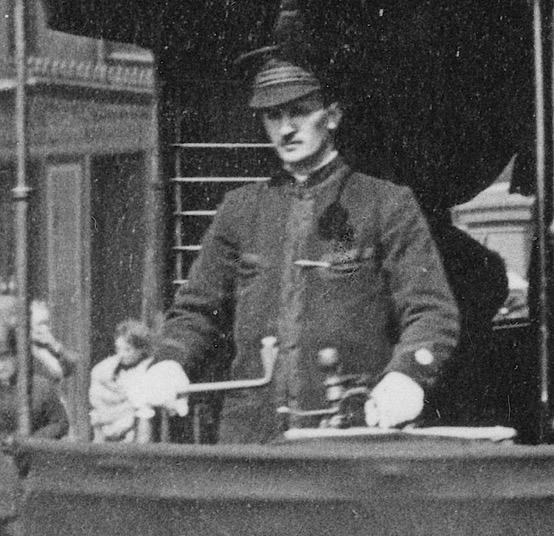
An enlargement of the above photograph showing the inspector who is driving the car.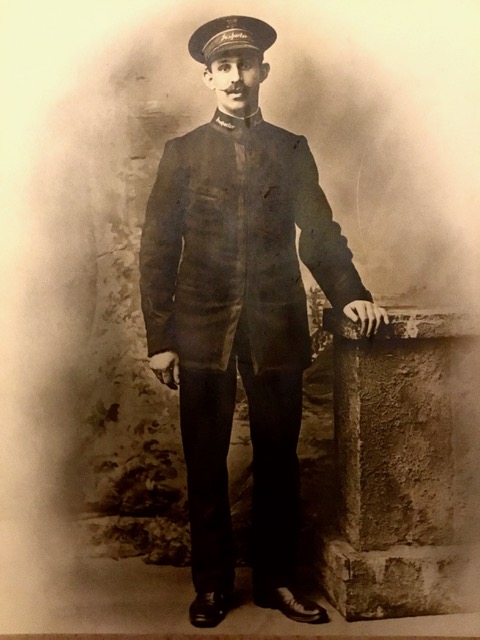
A studio portrait of LTCo Inspector James Reynolds, possibly taken on his promotion from the grade of motorman — photo undated, but probably taken in the years leading up to the Great War. Photo courtesy of Stephen Boyle via Blantyre Project.
Female staff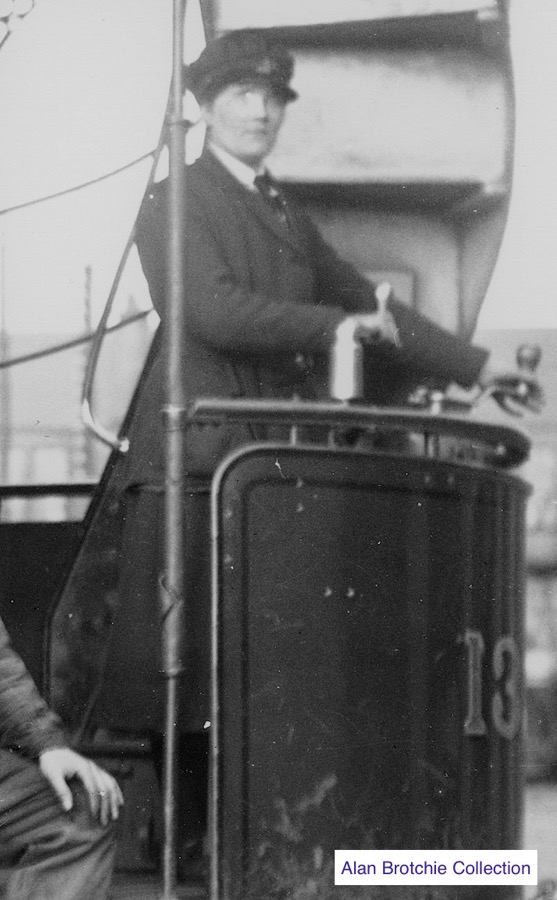
An LTCo female employee, thought to be an inspectress, at the controls of a rather battered-looking Tramcar 13, photo undated, but probably taken during the Great War or shortly thereafter.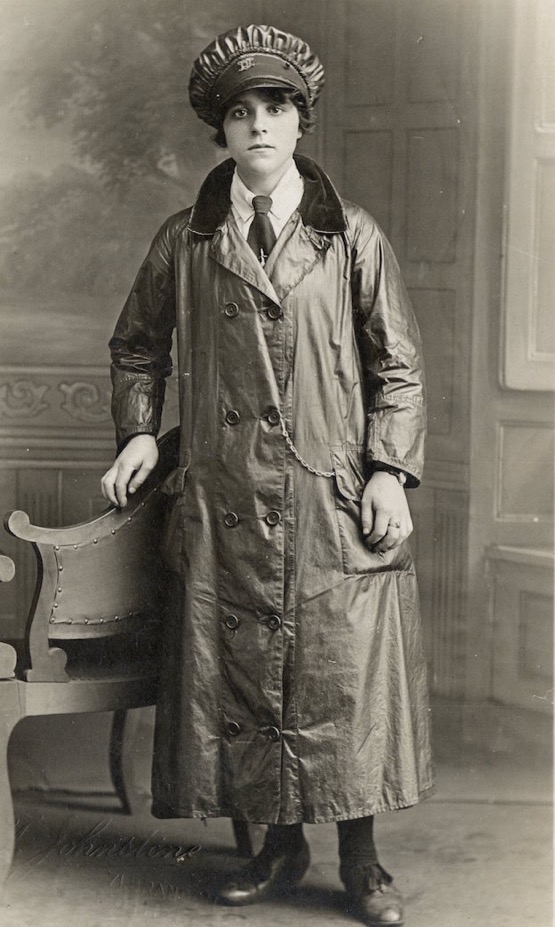
An excellent studio portrait of an LTCo lady driver, presumably a motorwoman given that bus driving (at that time) would have been considered to be far too physically demanding for the fairer sex — photo undated, but probably taken during the Great War. She is attired from head to toe in waterproof garments, presumably reflecting the inclement weather, and the exposed tramcar platforms. Author's Collection.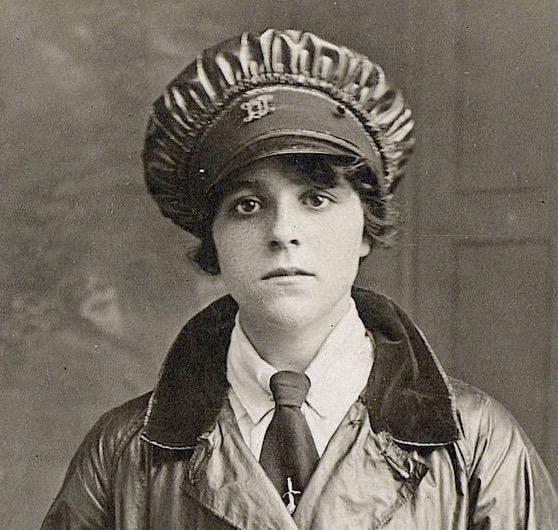
An enlargement of the above photograph, showing the cap and the LTC cap badge.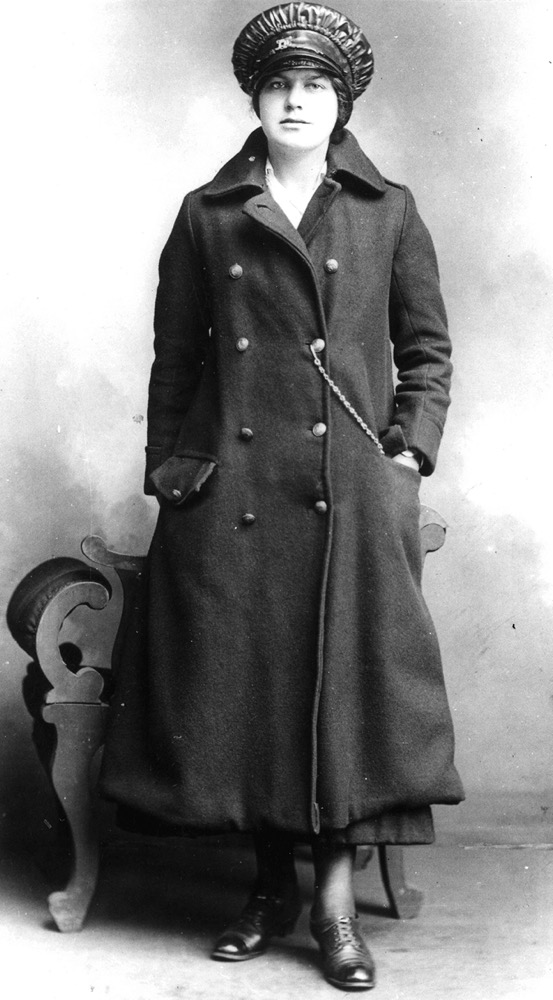
A studio portrait of conductress Barbara Craib, who was the grand-daughter of Forbes Christie, the Aberdeen Suburban Tramways Company Permanent Way Foreman. Miss Craib worked for a short time on the trams in Lanark (they recruited female staff from the Aberdeen area), but returned home when the ASTCo started hiring female staff. See the ASTCo page for a photo of Miss Craib on the trams in Aberdeen (link). With thanks to Mike Mitchell for the photograph and background information.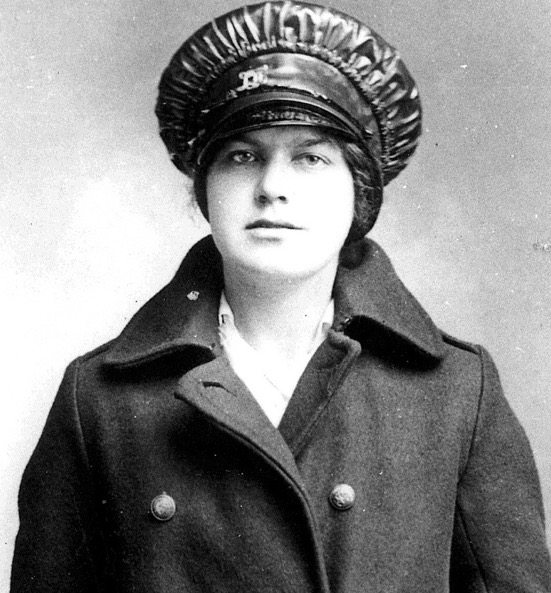
An enlargement of the above photograph, showing details of the uniform. The buttons are standard LTCo issues, whilst the cap would appear to bear the the LTCo cap badge, along with a script-lettering 'Conductor' badge. 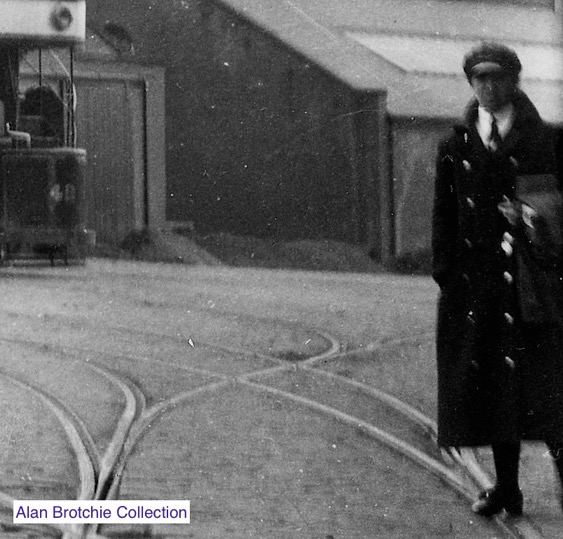
A blurred image, but one which does show an LTCo conductress, captured in the Power House depot yard along with Tramcar 42 in post-war livery — photo undated, but probably taken between 1919 and 1923, when this car was rebuilt. She is wearing a shirt and tie and has a baggy motor cap with a glossy peak.